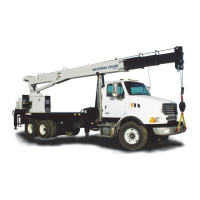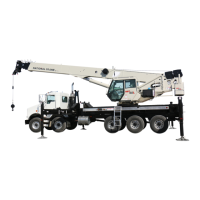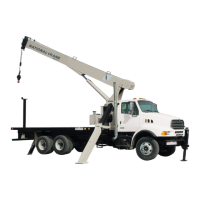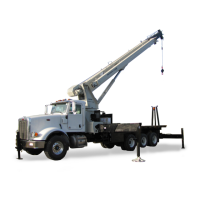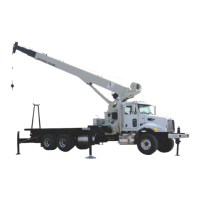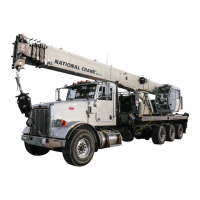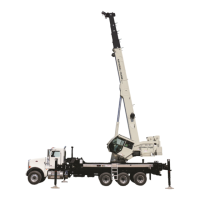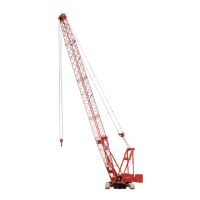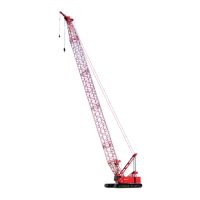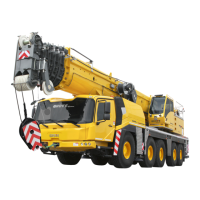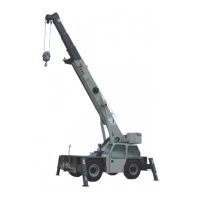3-12 Published 08/16/19 Control # 112-05
ELECTRIC SYSTEM 500E2 SERVICE MANUAL
switches are industrial grade, self-cleaning, environmental
sealed switches. To remove dirt, grease, oil, etc., wipe with a
cloth soaked with soap and water.
For those hard stains, a light alcohol based cleaner should
be used. Should moisture build up inside the housing,
remove the cover and allow to air dry. This process may be
sped up using a blow dryer set on a low heat range.
Quick Test for Receiver Antenna and Cable
Test the antenna harness with points A, B, C, D.
• Test Point A — Inner Conductor of Connector
• Test Point B — Outer Connector Housing
• Test Point C — Larger Ring Terminal
• Test Point D — Small Ring Terminal
Using an ohmmeter set at the minimum resistance scale,
make the following measurements with the antenna cable
disconnected from the receiver. With one meter test lead on
“A” and the other on “B”, there should be no continuity
(Maximum resistance reading). Next, attach one meter lead
to “A” and the other to “D”. There should be minimum
resistance (near 0 ohms). The same will be true at points “B”
and “C”. To do these last tests, another wire may have to be
used to extend the leads.
Troubleshooting
1. Begin the process of elimination by always checking the
fuse in the receiver first and then checking all wiring and
connectors (Look for dead shorts in wiring and
connections).
2. If the transmitting range drops or intermittent movement
occurs when activating a function, read the following:
a. Make sure the 9 volt battery is good in the
transmitter.
b. Be sure the antenna is free of vertical metal
obstruction (minimum 2 feet).
c. Any excess antenna cable should not be coiled
together.
d. Check antenna cable connector at the receiver. Be
certain the antenna is properly installed and that
there is nothing touching the bare portion of wires at
the antenna connection. (Be sure antenna is
installed properly.)
3. If a unit fails completely or if just one or two outputs are
not working, check the following:
a. Remove cover on the receiver and refer to the
“Receiver Printed Circuit Board” drawing,
Figure 3-6, in the installation instructions.
b. With power to the receiver, the Power Indicator LED
will be on. Turn transmitter power on. At this time the
receiver’s RF Indicator LED will be on for 10
seconds and you will hear the power relay engage.
(Anytime after transmitter power is on, a function
may be activated.) To verify that the power relay is
engaged and that the transmitter is transmitting,
activate the emergency stop on the transmitter. This
will disable the power relay and the transmitter will
transmit for 10 seconds.The RF and Power
Indicator LED’s will be on. During this time any
toggle switch activated will only send the
emergency stop signal. To reset the receiver and
transmitter, turn the transmitter power off and back
on. At this time the receiver’s RF Indicator LED will
be on for 10 seconds (without activating a toggle on
the transmitter) and you will hear the power relay
engage.
1. When a function is activated on the transmitter,
two or three LED’s are turned on in the receiver:
(1) RF Indicator LED, (2) Output Status
Indicator LED, (3) Master Control LED (may or
may not be utilized on the equipment).
2. With power relay engaged, check each function
by activating each toggle. Make sure that each
of the receivers Output Status Indicator LED’s
turn on. Suppose the appropriate Output Status
Indicator LED doesn’t come on, read ahead
through 4.
3. If the power relay doesn’t engage, there is a
possibility that the address codes are not
matching. Compare the 12 position address
switches in both transmitter and receiver and
then repeat step 3B. If they both match and still
the power relay doesn’t engage, set all 12 of the
dip switches to the OFF position in both the
receiver and transmitter and then repeat step
3B. At this point if the radio controller works or
not, call the factory to either be assigned a new
address code or to have the controller shipped
back to the factory for repair.
4. With a function activated and all three indicator
LED’s ON and there is no voltage registering on
the voltmeter, check the output fuse. There is a
7.5 amp fast blow fuse on each output. There is
an extra fuse and clip on the PC board. Remove
and replace blown fuse. If fuse repeatedly fails,
you may have a dead short in your wiring
harness or the electric coil or relay is failing. Do
not use anything other than the recommended
fuse furnished on the receiver PC board.
c. If the transmitter face plate has been removed and
replaced, then three problems could have been
introduced. Troubleshoot as follows:

